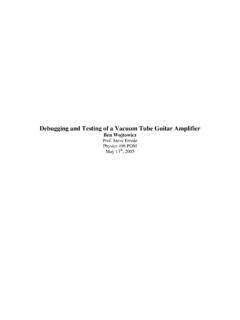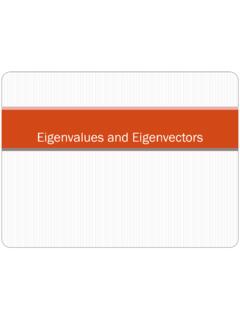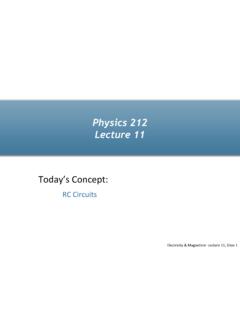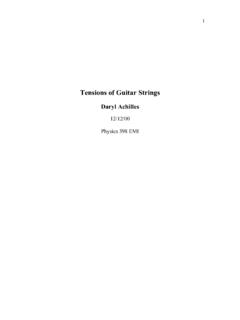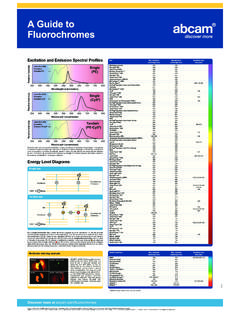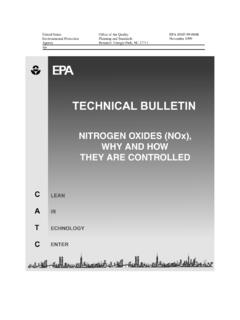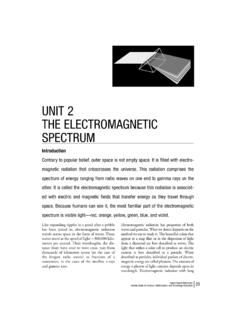Transcription of Linear attenuation coefficient - University of Illinois ...
1 Chapter 2: Interaction of Radiation with Matter Interaction of Photons with MatterNPRE 441, Principles of Radiation Protection, Spring 2021 Linear attenuation coefficientand Atomic attenuation coefficientLinear attenuation Coefficients Monochromatic photons are attenuated exponentially in a uniform target. The number of photons in a pencil beam interact within a small distance dx isChapter 2: Interaction of Radiation with Matter Interaction of Photons with MatterNPRE 441, Principles of Radiation Protection, Spring 2021 NdxdN xeNxN 0)(where is the Linear attenuationcoefficient and the solution to theabove differential equation isexp( x) is simply the probability of aphoton penetrating a distance xwithout attenuation Coefficients Linear attenuation coefficient is measured using the following setupChapter 2.
2 Interaction of Radiation with Matter Interaction of Photons with MatterNPRE 441, Principles of Radiation Protection, Spring 2021 Using small detector to avoid the effect of Compton scattered photons on themeasured Linear attenuation coefficient . Linear attenuation Coefficients Linear attenuation coefficientfor a given material comprises the individualcontributions from various physical processes,Chapter 2: Interaction of Radiation with Matter Interaction of Photons with MatterNPRE 441, Principles of Radiation Protection, Spring 2021As shown in the discussion of the attenuation of beta and alpha particles, themass attenuation coefficientis used to partially remove the dependence ondifferent atomic compositions and densities, and provides in an unifiedmeasure of photon attenuation amongst various materialspairComptonricphotoelect Mass attenuation coefficientis simply defined as,)/(/2gcmm Linear attenuation CoefficientsChapter 2.
3 Interaction of Radiation with Matter Interaction of Photons with MatterNPRE 441, Principles of Radiation Protection, Spring 2021 Atomic attenuation Coefficients Atomic attenuation coefficient (cross section per atom) the probability of aphoton is removed from the beam, when passing normally through a layer ofmaterial containing one atom per unit 2: Interaction of Radiation with Matter Interaction of Photons with MatterNPRE 441, Principles of Radiation Protection, Spring 2021 The atomic attenuation coefficientis also called themicroscopic crosssectionof an atom in the absorber material. It is the microscopic targetarea sustained by an atom in the absorber.
4 A cm 1 Natomscm3 Atomic attenuation CoefficientsThe numerical values for ahave been published for many elements and for arange of quantum 2: Interaction of Radiation with Matter Interaction of Photons with MatterNPRE 441, Principles of Radiation Protection, Spring 2021 Atomic attenuation CoefficientsAtomic attenuation coefficient (microscopic cross section per atom) a( )canbe related to the Linear attenuation coefficient ( ) as the following:Chapter 2: Interaction of Radiation with Matter Interaction of Photons with MatterNPRE 441, Principles of Radiation Protection, Spring 2021 where : Linear attenuation coefficient cm 1 : atmoic density No.
5 Of atoms per cm : atmoic cross section cm 2 attenuation CoefficientsChapter 2: Interaction of Radiation with Matter Interaction of Photons with MatterNPRE 441, Principles of Radiation Protection, Spring 2021 Thelinear attenuation coefficient ( )is related to the atomic attenuationcoefficient (microscopic cross section per atom) as the following:P170, <<Introduction to Health Physics>>, Third edition, by Cember. Number density of the n th atom in the compound or mixtureAttenuation Coefficients of an Alloy or a Compound Chapter 2: Interaction of Radiation with Matter Interaction of Photons with MatterNPRE 441, Principles of Radiation Protection, Spring 2021P170, <<Introduction to Health Physics>>, Third edition, by Cember.
6 (g) weight atomic :A)(cmsection cross atmoic :number sAvogadro' :)cmper atoms of ( atmoic :)/cmmaterial(g theofdensity :)(cmt coefficienn attenuatiolinear :2-03A3-1-0 AAAANNANorN attenuation CoefficientsChapter 2: Interaction of Radiation with Matter Interaction of Photons with MatterNPRE 441, Principles of Radiation Protection, Spring 2021 NCu: the number of Cu atoms per unitvolume of the mixture or CoefficientsChapter 2: Interaction of Radiation with Matter Interaction of Photons with MatterNPRE 441, Principles of Radiation Protection, Spring 2021 attenuation CoefficientsChapter 2: Interaction of Radiation with Matter Interaction of Photons with MatterNPRE 441, Principles of Radiation Protection, Spring 2021 photon attenuation Coefficients For photon energies between to 5 Mev, almost all materials have, on massattenuation coefficient basis, about the same gamma ray attenuationproperties.
7 The shielding properties of a given material is approximatelyproportional to the density of the material. For lower or higher energies, absorbers of high atomic number is much betterthan those of low atomic 2: Interaction of Radiation with Matter Interaction of Photons with MatterNPRE 441, Principles of Radiation Protection, Spring 2021 Chapter 2: Interaction of Radiation with Matter Interaction of Photons with MatterNPRE 441, Principles of Radiation Protection, Spring 2021 Energy transfer coefficient &Energy absorption coefficientEnergy transfer and Energy Absorption CoefficientsChapter 2: Interaction of Radiation with Matter Interaction of Photons with MatterNPRE 441, Principles of Radiation Protection, Spring 2021 For dosimetry applications, we are often interested in How much energy istransferredto the absorber?
8 And How much of the energy transferred is eventuallyabsorbedin the shielding?To answer these questions, It is important to consider thesecondary radiationsresultant from the interactions of the incidentgamma rays and the absorber. Under certain conditions, energy absorption inshielding material can be modeled with exponentialfunction ..Energy transfer and Energy Absorption CoefficientsChapter 2: Interaction of Radiation with Matter Interaction of Photons with MatterNPRE 441, Principles of Radiation Protection, Spring 2021 The photon fluence : the number of photons cross a unit area perpendicular to photon fluence rate: the number of photons per unit area per unit time.
9 (12 smdtd The energy fluence (Jm 2): the amount of energy passes per unit areaperpendicular to the energy fluence rate (Jm 2s 1): the amount of energy transfer per unit area perunit time.)(12 sJmdtd Energy transfer by a Gamma Ray BeamChapter 2: Interaction of Radiation with Matter Interaction of Photons with MatterAll characteristicX rays escapedMultiple Compton scattering ignoredAll Compton scattered gamma rays escapedCompton scatteringPhotoelectric effectAll photoelectrons, auger electrons and Compton recoil electrons are absorbedAll annihilation gamma rays escapedPair productionWhat is Energy transfer Coefficients?)
10 Chapter 2: Interaction of Radiation with Matter Interaction of Photons with MatterFor a parallel beam of monochromatic gamma rays transmitting through a unitdistance in an absorbing material,the energy transfer coefficient is the fraction ofenergy that was originally carried by the incident gamma ray beam andtransferred into the kinetic energy of secondary electronsinside the Effect Photoelectric interaction iswith the atom in a wholeand can not take placewith free theof frenquency theisconstant sPlanck' theis vhEhvEbe Photoelectric effectcreates a vacancy in one of the electron shells, whichleaves the atom at an excited 2: Interaction of Radiation with Matter Interaction of Photons with MatterInphotoelectricprocess, an incident photon transfer its energy to an orbitalelectron, causing it to be ejected from the 441, Principles of Radiation Protection, Spring 2021 Relaxation Process after Photoelectric EffectGeneration of characteristic X raysGeneration of Auger electronsCompeting Processes The excited atoms willde excitethrough one of the following processes: Auger electronemission dominates inlow X rayemission dominates inhigher 2.



